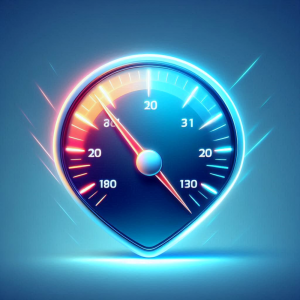
Have you ever clicked on a website only to leave seconds later because it took too long to load? If so, you’re not alone. Website speed plays a crucial role in user experience, search engine rankings, and conversion rates.
A slow website can drive visitors away, hurt your SEO rankings, and even reduce sales. In fact, studies show that a 1-second delay in page load time can lead to a 7% drop in conversions. That’s why having a fast website is essential for your business.
In this guide, we’ll explore why website speed matters, the factors affecting it, and proven ways to improve your website’s loading time.
📌 Let’s dive in!
1. Why Website Speed Matters
Your website’s loading speed impacts three critical areas:
📊 SEO & Google Rankings
Google prioritises fast-loading websites in its search rankings. In 2021, Google introduced Core Web Vitals, which measure:
✔ Largest Contentful Paint (LCP): How fast your main content loads.
✔ First Input Delay (FID): How quickly your site responds to user interactions.
✔ Cumulative Layout Shift (CLS): How stable your content is while loading.
Slow sites get penalised, while faster ones rank higher on Google and attract more traffic.
👥 User Experience & Engagement
🔹 40% of users abandon a website that takes longer than 3 seconds to load.
🔹 53% of mobile users leave if a page takes more than 3 seconds.
A fast website keeps visitors engaged, encourages them to explore, and reduces bounce rates.
💰 Conversions & Sales
Speed impacts sales and revenue!
✔ Amazon found that a 100-millisecond delay costs them 1% in revenue.
✔ Google’s research shows that a 0.1s improvement in load speed can increase conversions by 8%.
A slow website means lost customers and missed business opportunities.
2. How to Check Your Website Speed
Before improving your website speed, you need to measure your current performance.
✅ Use These Free Tools:
🔹 Google PageSpeed Insights (PageSpeed Insights) – Analyses your site’s speed and provides recommendations.
🔹 GTmetrix (GTmetrix) – Offers detailed performance reports.
🔹 Pingdom (Pingdom) – Tests speed from multiple global locations.
🔹 Google Lighthouse – Provides insights for mobile and desktop performance.
Once you’ve analysed your site, use the tips below to speed things up!
3. How to Improve Your Website Speed
🚀 1. Choose the Right Hosting Plan
Your web hosting provider plays a major role in website speed. A slow host = a slow website.
Best Hosting Options:
✅ Shared Hosting: Budget-friendly but slower. Suitable for small websites.
✅ VPS Hosting: Offers better performance and scalability.
✅ Dedicated Server: Best for high-traffic websites.
✅ Managed Hosting: Fully optimised for speed and security.
👉 Need fast & reliable hosting? Check out TownHost’s Hosting Solutions.
📷 2. Optimise Images & Media Files
Large images slow down your website. Compress them using:
✔ TinyPNG (TinyPNG)
✔ ShortPixel (ShortPixel)
✔ WebP Format – A modern image format that loads faster than PNGs or JPEGs.
🔹 Tip: Use lazy loading to load images only when users scroll down.
🛠️ 3. Minimise CSS, JavaScript & HTML
Too many files increase loading time. Use minification tools like:
✔ WP Rocket (WordPress plugin)
✔ Autoptimize (WordPress plugin)
✔ Google PageSpeed Insights (to identify issues)
🗂️ 4. Use a Content Delivery Network (CDN)
A CDN speeds up loading times by distributing website files across global servers. Popular CDNs include:
✔ Cloudflare (Cloudflare)
✔ Amazon CloudFront
✔ StackPath
🕵️ 5. Reduce Server Requests
🔹 Too many HTTP requests slow down your site.
🔹 Combine CSS & JavaScript files, reduce redirects, and eliminate unnecessary plugins.
Use GTmetrix to analyse requests and fix performance bottlenecks.
📜 6. Enable Caching
Caching stores website data, reducing server load and speeding up repeat visits.
✔ Use WP Super Cache or W3 Total Cache for WordPress.
✔ Enable browser caching to reduce load times.
⚙️ 7. Upgrade to PHP 8.0 or Higher
If you use WordPress, upgrading to PHP 8.0+ can boost website speed by up to 30%.
Check your hosting settings and update your PHP version.
📊 8. Optimise Your Database
Over time, databases become cluttered with unnecessary data.
✔ Use WP-Optimize to clean up old revisions, spam comments, and unused tables.
4. Mobile Speed Optimisation
Mobile users expect fast-loading websites. Here’s how to optimise for mobile:
📱 Use Responsive Design – Ensure your site adapts to all screen sizes.
⚡ Enable Accelerated Mobile Pages (AMP) – Faster loading for mobile users.
🛠 Optimise Mobile Images – Ensure images are properly compressed for mobile.
5. Final Thoughts
Website speed directly impacts SEO, user experience, and conversions. A slow site can lead to lost traffic and sales, while a fast site keeps visitors engaged and improves Google rankings.
By following the tips above, you can significantly boost your website speed and provide a seamless experience for your users.
🚀 Want high-speed hosting for your business? Check out TownHost’s Hosting Services today!
